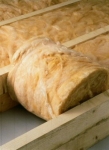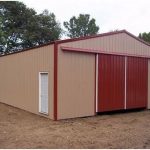A reader writes (spelling, grammar errors included):
“When I built my barn I had 2″ insulation bats put between the outside framing and the tin. The side toward the tin is just open insulation. The inside is that heavy with plastic or whatever it is. I built with books shelve perlins on 2′ centers. Thinking it would make it an easy job to just fill those cavities with insulation.
Where I’m confused is on the vapor barrier. We have a local business that makes insulation. Actually my insulation came from them. They guy there told me to just slice open the white vapor barrier and add insulation then use plastic over the added insulation prior to finishing my walls. So I’m just looking for affirmation that this is the correct way to go. Or other ideas and opinions.
Thanks.”
From the description, I will assume the two inch insulation batts are what is known as Metal Building Insulation. This type of insulation is actually designed to reduce condensation issues in building which have steel roofing and/or siding applied directly over roof purlins or wall girts.
Metal Building Insulation is not an effective insulator, as the fiberglass insulation gets crushed down to nothing every time it crosses a framing member.
This particular building is designed with sidewall framing (girts actually, not purlins which are on a roof) placed bookshelf style to create an insulation cavity. The builder did not do his customer any favors and actually spent his customer’s money unwisely.
 Moisture within the walls of a pole building can cause serious problems. In the colder months, moisture tends to move from the inside to the outside of buildings. As it passes through the walls, it may condense within them, causing the potential for rot and mildew. In walls with insulation, the water may condense within the insulation decreasing its R-value. In the worst case, moisture can actually freeze within the walls, accumulating until a thaw melts it and causes visible damage such as wall or ceiling staining!
Moisture within the walls of a pole building can cause serious problems. In the colder months, moisture tends to move from the inside to the outside of buildings. As it passes through the walls, it may condense within them, causing the potential for rot and mildew. In walls with insulation, the water may condense within the insulation decreasing its R-value. In the worst case, moisture can actually freeze within the walls, accumulating until a thaw melts it and causes visible damage such as wall or ceiling staining!
A vapor barrier is designed to keep moisture in pole barns from getting inside exterior walls. Batt and roll insulations usually come with a vapor barrier attached. However, leakage can occur where the facings meet. This is especially true if the facings are not stapled to the inside of the wall girts, but instead the insulation is just pressed into place or stapled on the inside of the girt (all too common of a practice with foil faced insulation). For the best possible vapor barrier, supplement the facing by installing a 4mil or thicker clear plastic sheet over the inside of the entire framed wall before installing any interior finishes (like gypsum wallboard).
Never sandwich the insulation between two vapor barriers. For example, do not install insulation with the vapor barrier facing the climate controlled space and then put plastic sheeting, or some type of vapor barrier, across the outside of the framing. Since some leakage of moisture into the insulation in inevitable, it needs to be able to freely escape from the insulation to the outside world ….. not be trapped inside!








